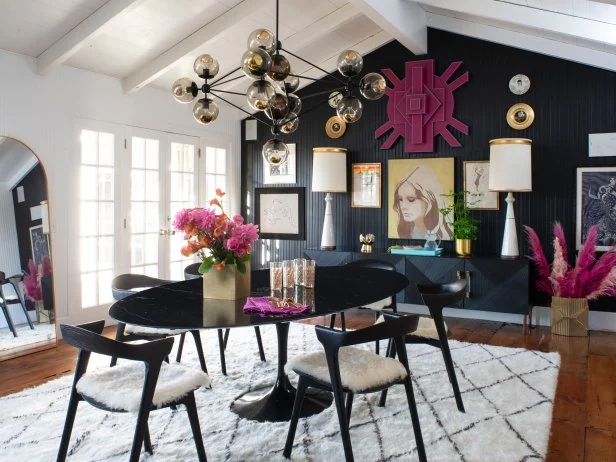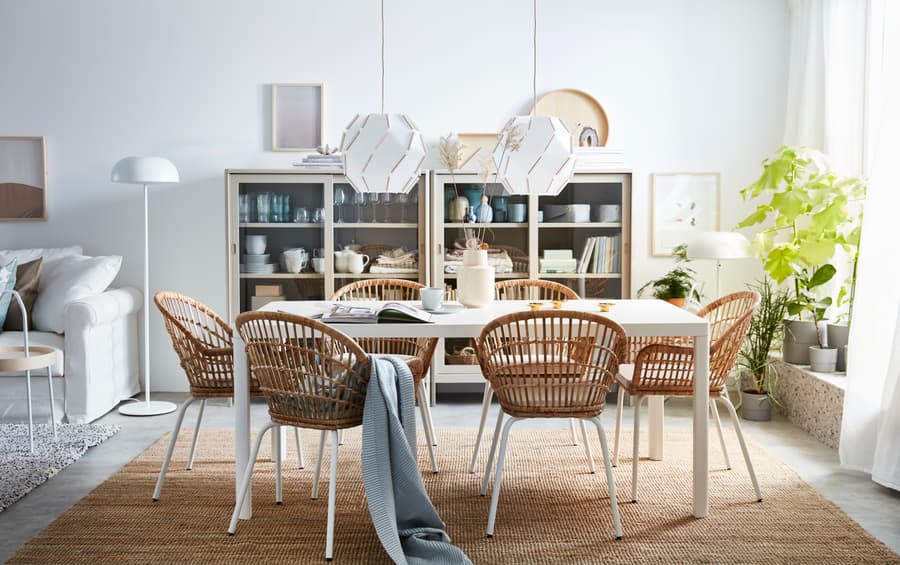Are you looking to give your dining room a fresh, unique look without breaking the bank? Mixing and matching furniture is a stylish way to create a space that feels both inviting and personal.
But it can be tricky to know where to start or how to make different pieces work together. You’ll discover simple tips to blend colors, styles, and textures effortlessly. By the end, you’ll have the confidence to design a dining area that truly reflects your taste and welcomes everyone to gather around.
Ready to transform your dining room into a space you love? Let’s dive in!
Choosing A Color Palette
Choosing a color palette sets the tone for your dining room. It helps create a balanced and inviting space. The right colors make mixing and matching furniture easier. They bring harmony and style to your room. Below are two popular color choices to consider.
Neutral Tones
Neutral colors are soft and calming. Shades like beige, gray, and white work well together. They create a simple and clean look. Neutral tones allow you to mix different furniture styles easily.
Use these tips for neutral palettes:
- Pick one main neutral color for walls or large pieces.
- Add texture with wood, linen, or metal furniture.
- Include small accents in soft colors like pastel blue or green.
- Keep the room light and airy with natural light or soft lighting.
Bold Statements
Bold colors add energy and personality. Deep blues, rich reds, or vibrant greens make a strong impact. They help highlight unique furniture pieces.
Try these ideas for bold palettes:
- Choose one bold color as a focal point on a wall or chair.
- Balance it with neutral or muted tones on other furniture.
- Mix patterns carefully to avoid visual clutter.
- Use bold colors in small doses for a fresh look.
Incorporating Different Materials
Mixing different materials in your dining room furniture can create a dynamic and inviting space. It adds texture and depth, making your room feel more personalized and stylish. But how do you balance these materials without overwhelming the space?
Wood And Metal
Combining wood and metal is a popular choice that blends warmth with industrial edge. You might pair a solid wood dining table with sleek metal chairs to add contrast.
Think about the finish and color of each material. A dark wood table works well with matte black metal legs for a modern look. Alternatively, light wood with brushed steel can brighten the room while keeping it contemporary.
Consider how these materials interact with light and wear over time. Metal can feel cold, so adding cushions or a wooden bench can soften the vibe. Have you tried mixing metal chairs with a wooden bench to create an inviting seating area?
Glass And Fabric
Glass tops bring a sense of openness and elegance to your dining room. When combined with fabric chairs, they create a balance of smooth and soft textures.
Choose fabric colors that complement your room’s palette. Neutral tones like beige or gray work well, but don’t shy away from bold colors if you want a statement piece. Patterned fabrics can also add personality without cluttering the space.
Keep in mind that glass surfaces require regular cleaning but help reflect light, making smaller rooms appear larger. Pairing glass with cushioned fabric seating invites comfort and style—perfect for long dinners and lively conversations.
Balancing Modern And Vintage Styles
Balancing modern and vintage styles creates a dining room with unique charm. Mixing these styles adds character and warmth. It also keeps the space fresh and inviting. The key lies in blending old and new pieces thoughtfully. Achieve harmony by choosing elements that complement each other. This balance makes your dining room stand out while feeling cozy.
Integrating Classic Pieces
Start by selecting vintage furniture with timeless appeal. Look for items with rich wood tones or intricate details. These pieces bring history and personality to your space. Place a classic dining table or chairs as a focal point. Use vintage lighting fixtures like chandeliers or sconces. These add elegance without overwhelming the room.
Keep vintage pieces well maintained to showcase their beauty. Pair them with neutral walls and floors. This allows the furniture to shine without clashing. Mixing styles works best when classic pieces feel intentional, not random.
Adding Contemporary Flair
Introduce modern furniture with clean lines and simple shapes. Choose sleek chairs or a minimalist buffet cabinet. These items create contrast and balance vintage richness. Use modern accessories such as abstract art or geometric rugs. They inject freshness and energy into the dining room.
Opt for lighter colors or metallic finishes in contemporary pieces. These brighten the space and add subtle shine. Mixing different textures like glass, metal, and wood also enhances interest. The goal is to blend modern flair without losing warmth from vintage items.

Credit: www.hgtv.com
Playing With Patterns And Textures
Playing with patterns and textures brings life to your dining room. It creates interest and a cozy feel. Mixing different designs and materials can make your space unique.
Patterns and textures add depth and character. They break the monotony of plain furniture. Using them carefully helps balance the overall look.
Mixing Patterns
Mixing patterns can be fun and stylish. Use simple shapes like stripes or dots with bold floral prints. Keep the colors within the same family to avoid clashing.
- Start with one large patterned piece, like a rug or chair.
- Add smaller accents, such as cushions or table runners.
- Combine different scales of patterns: big, medium, and small.
This approach keeps the room lively without feeling chaotic.
Using Textures
Texture adds a tactile dimension to your dining space. Mix smooth, rough, soft, and hard surfaces for a balanced look.
- Pair wooden chairs with a velvet cushion.
- Use a metal or glass table with a woven rug underneath.
- Add linen or cotton napkins for softness.
Textures invite touch and make the room feel warm and inviting.
Creating A Focal Point
Creating a focal point in your dining room helps guide the eye and sets the mood. It brings balance to mixed furniture styles and adds charm to the space. A strong focal point draws attention and makes the room feel inviting and cohesive.
Statement Lighting
Lighting can be the star of your dining room. Choose a chandelier or pendant light that stands out in size or design. This piece anchors the space and highlights your dining table. Unique shapes or bold colors make lighting more than just functional.
Position the light directly above the table for clear focus. Use dimmers to adjust brightness and create atmosphere. The right lighting adds warmth and style to your mixed furniture layout.
Art And Decor
Wall art creates visual interest and complements your furniture choices. Large paintings or framed prints can serve as a striking backdrop. Pick colors from your furniture to tie the room together.
Decorate with items like vases, sculptures, or plants. These small touches add personality and texture. Arrange decor thoughtfully to keep the space balanced and inviting. Art and decor complete your dining room’s focal point with style and charm.
Optimizing Space With Furniture Arrangement
Optimizing space with furniture arrangement in your dining room helps create a comfortable and inviting area. Thoughtful placement makes the room look larger and more organized. It also enhances the dining experience by providing enough space to move around easily. Smart arrangements blend style and function without crowding the room.
Space-saving Tips
- Choose a round or oval table to save corner space.
- Use benches instead of chairs for flexible seating.
- Pick furniture with built-in storage to reduce clutter.
- Place smaller items like side tables in unused corners.
- Opt for stackable or foldable chairs for extra guests.
Flow And Accessibility
Keep pathways clear for easy movement around the dining area. Allow at least 30 inches between the table and walls or other furniture. Avoid blocking doors or windows with large pieces. Arrange chairs so guests can sit and stand without hassle. A smooth flow improves comfort and usability in the space.
Personalizing With Accessories
Accessories bring life to your dining room mix and match style. They create a unique look that reflects your personality. Small touches can make a big impact. Accessories also tie different furniture pieces together. Choose items that enhance the overall theme and color scheme.
Table Settings
Table settings offer a simple way to personalize your dining space. Use placemats and napkins in colors that complement your furniture. Mix patterns and textures for a rich look. Consider using different plates and glassware styles to add charm. Fresh flowers or candles create warmth and invite guests to stay longer.
Unique Accents
Unique accents add character and interest to your dining room. Think about vintage vases, art pieces, or decorative bowls. Items with different shapes or materials catch the eye. Display books, sculptures, or handmade crafts on sideboards or shelves. These accents reflect your style and make the space feel welcoming.

Credit: www.hgtv.com
Considering Functionality And Comfort
Choosing furniture for your dining room means thinking about both function and comfort. Your space should feel welcoming and work well for meals and gatherings. Comfort keeps guests happy and makes every meal more enjoyable. Functionality helps your dining room stay practical and easy to use. Balance these two aspects to create a room that looks great and feels right.
Chair Selection
Pick chairs that are comfortable for long meals and fit your style. Consider padded seats or cushions for extra softness. Chairs with armrests add support but need more space. Mix different chair styles carefully to keep harmony. Test the height so people sit comfortably at the table. Don’t forget about durability; choose materials that last and are easy to clean.
Table Dimensions
Choose a table size that fits your room and the number of people. Leave enough space around the table for easy movement. A good rule is to have at least 36 inches between the table edge and walls or furniture. Round tables can save space and create a cozy feel. Rectangular tables often fit more guests but need more room. Match the table height with your chairs for better comfort.

Credit: www.ikea.com
Frequently Asked Questions
How To Choose Furniture Styles That Complement Each Other?
Pick styles with common elements like color, material, or design. Balance modern and traditional pieces for harmony. Use neutral tones to unify diverse furniture.
Can I Mix Different Wood Finishes In Dining Furniture?
Yes, mixing wood finishes adds depth and interest. Keep finishes within a similar tone range for cohesion. Avoid clashing colors to maintain balance.
What Are Tips For Mixing Dining Chairs Effectively?
Combine chairs with similar shapes or colors. Use a consistent style theme for unity. Mix textures and materials for visual appeal.
How To Create A Focal Point In Mixed Dining Room Furniture?
Use a standout piece like a unique table or chandelier. Coordinate surrounding furniture to highlight the focal point. Keep other elements subtle to avoid clutter.
Conclusion
Mixing and matching dining room furniture adds character and style. Choose pieces that share a color or theme for balance. Don’t be afraid to mix different textures or shapes. Keep comfort and function in mind for daily use. Small details like cushions or rugs tie the look together.
Your dining room will feel unique and inviting. Enjoy the process of creating a space that reflects you. This approach makes decorating fun and personal. Try different combinations until you find the right fit.
